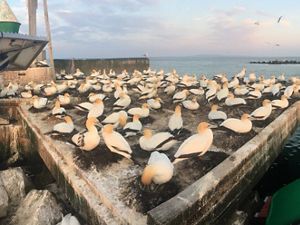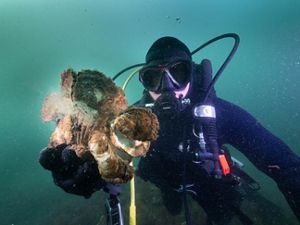Watching our underwater Reef Cam is a great way to explore the rich and diverse underwater world of Pope’s Eye, within Port Phillip Heads Marine National Park at Port Phillip Bay, Victoria.
In early 2023, TNC handed over operation and management of Reef Cam, now known as The Great Southern Reef Camera Network, to our friends at Southern Ocean Environmental Link (SOEL). As a not-for-profit organisation based in Queenscliff, SOEL are just a short boat trip from the camera location. There is much more in store for Reef Cam so stay tuned as SOEL builds on TNC’s legacy!
Read about the fishes of Pope’s Eye below, then watch Reef Cam to see how many you can spot!
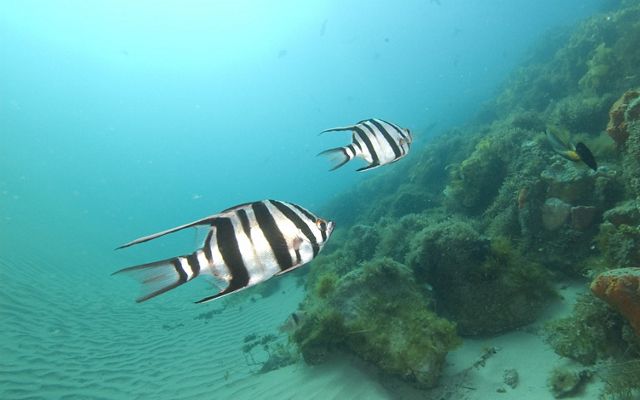
Old Wife
Scientific name: Enoplosus armatus
Other names: Angelfish, Bastard Dory, Double Scalare, Moonlighter, Zebra Fish
Max size: 30cm
Diet: Carnivore – Feeds on small invertebrates. Old Wives may set up cleaning stations and remove parasites from other fishes.
Habitat: On rocky reefs, and around jetties and pier piles in bays, harbours and in sheltered areas along the coast; juveniles often shelter in seagrass beds, in depths of 0-85m.
General description: The Old Wife is easily recognised by its deep compressed body, very tall “spikey” dorsal and anal fins and prominent dark brown to black and white bands. Be careful as they have venomous fin spines!
The name “Old Wife” reportedly refers to the sound made by this species grinding its teeth when caught on hook and line.
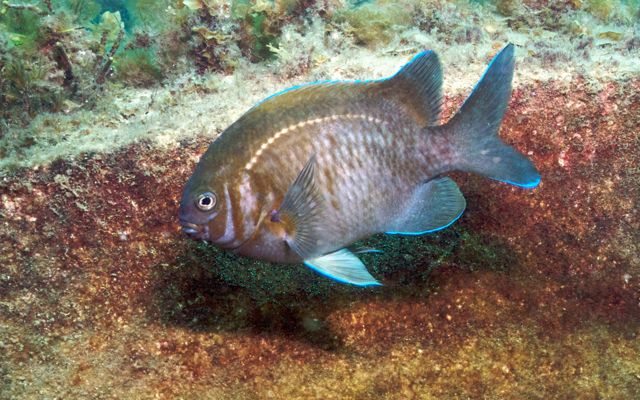
Victorian Scalyfin
Scientific name: Parma victoriae
Other names: Common Scalyfin, Rock Perch, Scaly Fin, Victorian Rock Perch
Max size: 25cm
Diet: Herbivore – Grazes on small algal “gardens” in their home.
Habitat: Rocky reefs in bays, harbours and along the coast in southern Australia.
General description: Small juveniles are bright orange with neon-blue lines, spots and a black ocellus ringed with neon-blue on the dorsal fin. Large adults are dark greyish to black, or rusty-coloured, often becoming paler below, with a dusky head, and pale spots along lateral line.
Divers are very familiar with these small damselfishes, especially during the breeding season (between November and February) when they aggressively guard their territories.

Yellow-striped Leatherjacket
Scientific name: Meuschenia flavolineata
Other names: Orange-tailed Leatherjacket, Yellow-tailed Leatherjacket
Max size: 30cm
Diet: Carnivore – Feeds on benthic invertebrates.
Habitat: Coastal reefs, particularly those offshore, in depths of 1-30m.
General description: Often seen in pairs. A blackish to greenish brown leatherjacket, with a large yellow or orange blotch on the tail base, often continued as a yellow stripe along the midsides.
Males have a patch of fine bristles and two pairs of large spines on the tail base. Females and juveniles lack the bristles and the spines are small to minute.
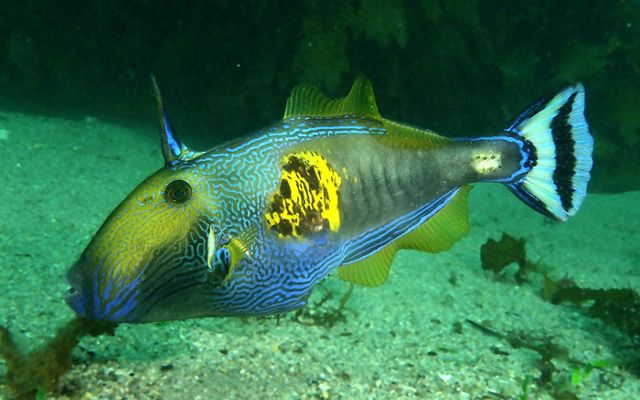
Sixspine Leatherjaket
Scientific name: Meuschenia freycineti
Other names: Freycinet’s Leatherjacket, Grey Leatherjacket, Orange-spotted Leatherjacket, Reef Leatherjacket, Skottowe’s Leatherjacket, Variable Leatherjacket
Max size: 55cm
Diet: Carnivore – Feeds on benthic invertebrates, including hydroids, molluscs, crustaceans and polychaete worms, as well as consuming some epiphytic algae.
Habitat: On shallow reefs in bays, harbours and along the coast in depths to 145m; juveniles in sheltered areas, especially seagrass beds.
General description: Highly variable colour pattern, adults have two to four pairs of curved spines on each side of the tail base, that are larger in males than in females and juveniles. Both males and females have a distinct dark crescent-shaped band near the hind margin of the tail.
Males are bluish with fine blue lines and spots on the head, blue lines along the dorsal and anal-fin bases, and often a large yellow to orange patch, or indistinct yellowy blotches on the sides.
Females and juveniles are pale greenish, yellow or brown, with blue lines and spots on the head and several broad dark stripes along the sides.
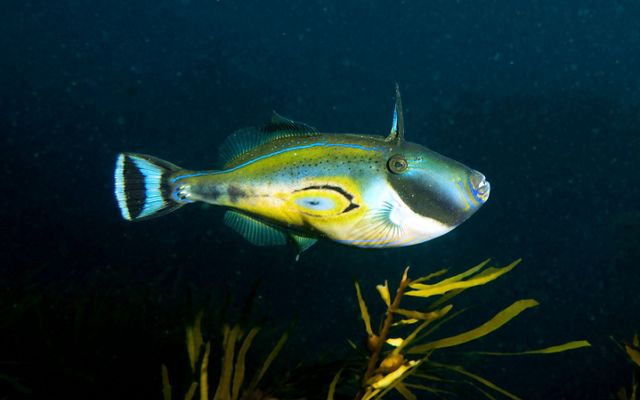
Horseshoe Leatherjacket
Scientific name: Meuschenia hippocrepis
Other names: Purple People Eater, Variable Leatherjacket
Max size: 60cm
Diet: Carnivore – Feeds on a range of benthic invertebrates. They also feed on jellyfishes such as Blue Blubber.
Habitat: Shallow reefs in bays, harbours and along the coast in depths to 145 m; juveniles in sheltered areas, especially seagrass beds.
General description: A striking and easily recognised leatherjacket with a distinct horseshoe-shaped marking on the midside. Males are much more brightly-coloured than females, and adults also have two pairs of curved spines on each side of the caudal peduncle (the narrow part of a fish’s body where the tail fin is attached).
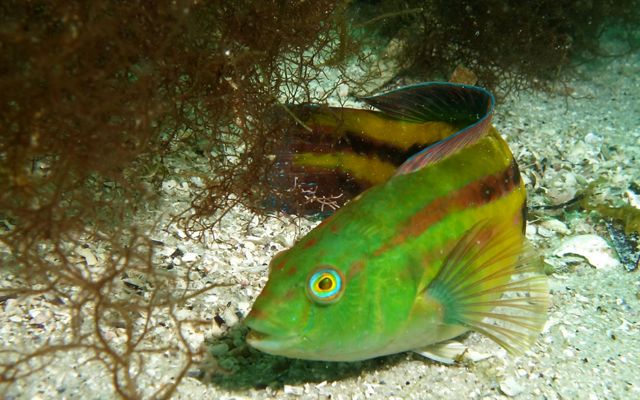
Senator Wrasse
Scientific name: Pictilabrus laticlavius
Other names: Green Parrotfish, Patrician Wrasse, Purple-banded Wrasse, Senator Fish
Max size: 30cm
Diet: Carnivore – Feeds on a range of benthic invertebrates, such as crustaceans (amphipods and small decapods) and gastropod molluscs.
Habitat: Common in kelp and macro-algal beds on coastal reefs in 3-40m.
General description: Males are green with maroon or purplish stripes along the sides. Females and juveniles are reddish to greenish-brown with a row of black spots above the lateral line, 4-5 dusky bars on the lower sides and a black spot on the rear of the dorsal fin.
The Senator Wrasse is a protogynous hermaphrodite, meaning that individuals mature into females (Initial Phase) during their first year, and change sex into males (Terminal Phase) during their second to fifth year. They have a life span of up to 10 years. Spawning occurs during spring and summer months.
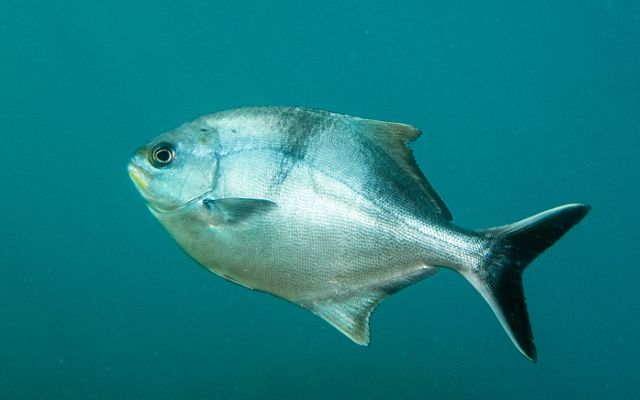
Sea Sweep
Scientific name: Scorpus aequipinnis
Other names: Maomao, Silver Sweep, Snapjack, Sweep
Max size: 48cm
Diet: Omnivores – Browses on algae and zooplankton. They are an active schooling species, often seen feeding on plankton well above the bottom.
Habitat: Inshore rocky reefs, in depths of 1-25m.
General description: A relatively large greyish sweep with a bluish, greenish or brownish tinge, and two broad dusky bands or saddles on the upper sides. Sea Sweep have prominent raised lobes on the dorsal and anal fins, a large forked tail and small pectoral fins.
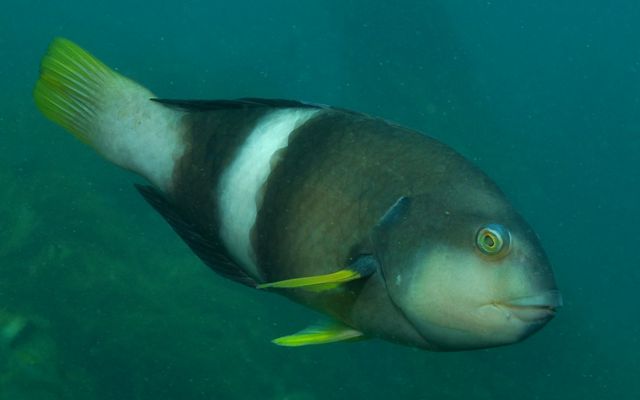
Bluethroat Wrasse
Scientific name: Notolabrus tetricus
Other names: Bluehead, Bluehead Parrotfish, Bluenose, Bluenose Parrotfish, Blue-throat Parrot Fish, Bluethroat Parrotfish, Kelpie, Lilac Banded Parrotfish, Rocky Bream, Rocky Cod, Rotfish, Winter Bream
Max size: 50cm
Diet: Carnivore – Mostly feeds on crustaceans and molluscs.
Habitat: Adults usually on deep exposed rocky reefs, juveniles in shallower weedy areas, in depths of 1-160m.
General description: Juveniles and females are a greenish-brown with a broad blackish bar around the middle of the body. As they grow, females become lighter behind the dark bar. Males have a bluish head, a blue throat, a distinct white band around the rear of the body, yellow pectoral and pelvic fins and a white caudal peduncle (the narrow part of a fish’s body where the tail fin is attached).
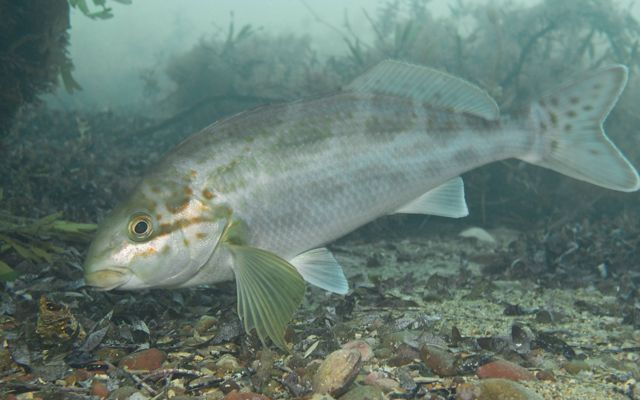
Dusky Morwong
Scientific name: Dactylophora nigricans
Other names: Black Butterfish, Butter Perch, Butterfish, Nunckla, Nunda, Shitfish, Strongfish, Tillywurti
Max size: 120cm
Diet: Carnivore – Feeds on polychaetes, isopods, amphipods and brown algae.
Habitat: Sheltered and exposed coastal reefs, in caves and under overhangs, in depths of 0-50m.
General description: A large slender greyish to brownish morwong with a whitish belly. Immature individuals are silvery with rows of orange-brown spots along the sides and dark spots on the dorsal and caudal fins. Small juveniles have deeper silvery bodies with broad dark bands on the upper sides that extend onto the dorsal fin.

Southern Hulafish
Scientific name: Trachinops caudimaculatus
Other names: Blotched-tailed Trachinop
Max size: 15cm
Diet: Omnivore – Feeds on zooplankton.
Habitat: Sheltered coastal reefs and rocky areas in bays and estuaries, in depths of 1-35m.
General description: Pinkish-brown with a large black blotch on the tail base, and a bright blue eye. Their common name is derived from the behaviour of constantly flicking their tails, resembling the skirts of hula dancers.

Western Blue Groper
Scientific name: Achoerodus gouldii
Other names: Blue Groper, Gould’s Wrasse , Western Blue Wrasse
Max size: 180cm
Diet: Carnivore – Feeds on small crabs, smaller crustaceans, sea urchins and molluscs, including abalone. They use their strong peg-like teeth to prise urchins and molluscs off rocks, and will also bite off pieces of algal mat to eat small crustaceans and other benthic invertebrates that live amongst the algae.
Habitat: Exposed rocky reefs in coastal waters of southern and south-western Australia above 65m.
General description: These large inquisitive wrasses are hermaphrodites and may change sex from female to male during their life cycle. Juveniles are greenish with scattered pale spots. Adult females are typically greyish-green to reddish in colour, and the males are greyish to bright blue. They have a single long-based dorsal fin, a large squarish tail, thick fleshy lips, large heavy scales and peg-like teeth. They live up to an incredible 70 years of age.
Conservation: Recorded on the IUCN Red List as vulnerable. Western Blue Groper are site-attached meaning that they tend to remain in ‘home range’, and are vulnerable to overfishing. In the past, they have been exploited by spearfishers and anglers because of their large size and reputation as an excellent eating fish, causing numbers to decline.
It is impacted by commercial and recreational fishing throughout its locations with declines of 60-90% over the past 20 years (since at least the 1990s). Today, they are protected from fishing in designated areas across the southern coast of Australia including, Rottnest Island Marine Reserve in Western Australia, Spencer Gulf and Gulf St Vincent in South Australia. In Victoria it is completely protected.
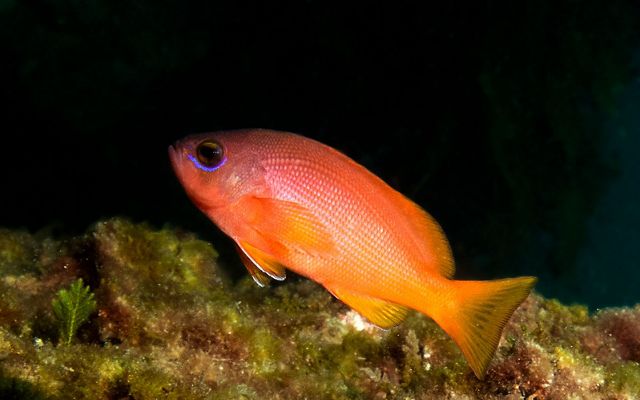
Barber Perch
Scientific name: Caesioperca razor
Other names: Barber Sea Perch, Red Perch, Tasmanian Barber
Max size: 26cm
Diet: Omnivore – Feeds on plankton above rocky reefs, outcrops and drop offs.
Habitat: These fish form large schools on sheltered coastal reefs, above rocky reefs, outcrops and drop offs, in depths of 7-100m.
General description: Adult males are bluish with a black bar on the side. Females are pinkish with a blue line below the eye. Small juveniles are pink to pinkish-orange with a dark mauve head.
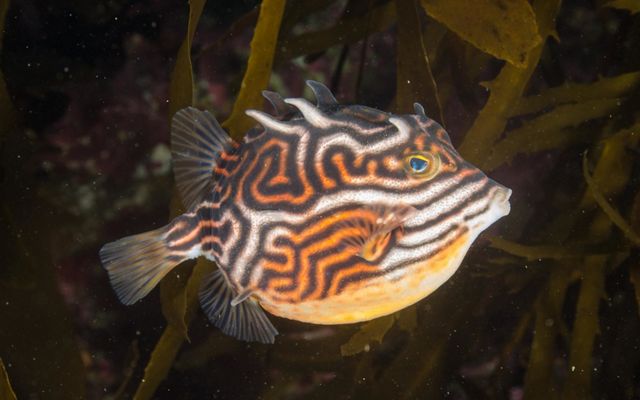
Shaw's Cowfish
Scientific name: Aracana aurita
Other names: Painted Boxfish, Southern Cowfish, Striped Cowfish
Max size: 25cm
Diet: Carnivore – Feeds on a range of benthic invertebrates, often exposing its prey by blowing a jet of water onto the sediment.
Habitat: Rocky reefs and seagrass beds in sheltered bays and harbours and along the coast in depths of 10-160m.
General description: The brightly-coloured males have pale blue wavy lines and spots over an orange background. Females and juveniles have irregular brown wavy lines and stripes on a pale background.
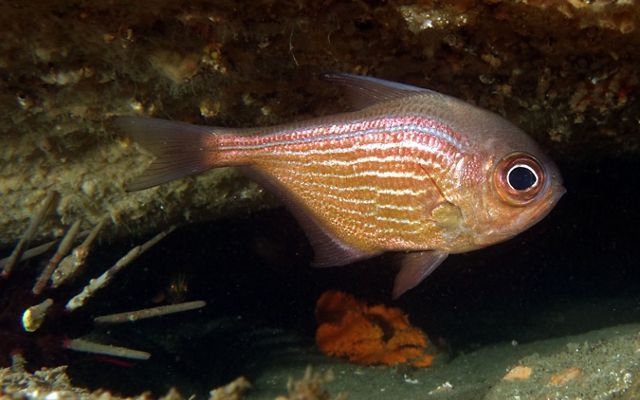
Bigscale Bullseye
Scientific name: Pempheris multiradiata
Other names: Big-scaled Bullseye, Common Bullseye, Large-scaled Bullseye
Max size: 28cm
Diet: Carnivore
Habitat: Rocky reefs, in depths of 2-70 m
General description: A silvery-brown bullseye with brown markings along scales giving a striped appearance, and dusky fins. Juveniles are paler, and black tips on the dorsal, anal and yellow pelvic fins.
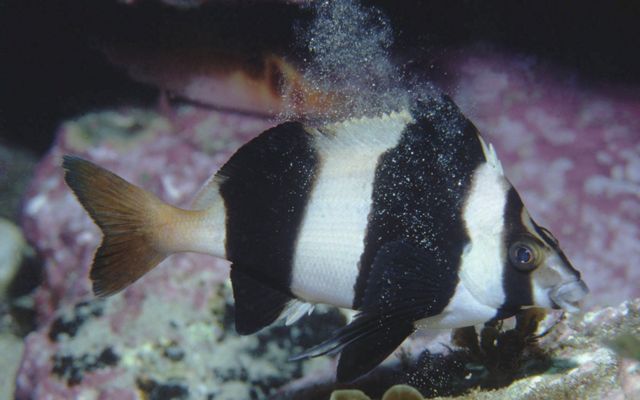
Magpie Perch
Scientific name: Cheilodactylus nigripes
Other names: Black-striped Morwong, Magpie Morwong
Max size: 40cm
Diet: Carnivore – Feeds on molluscs, polychaete worms and algae
Habitat: Sheltered and exposed coastal reefs, found in caves and under overhangs, in depths of 0-25m.
General description: Body with three broad black bands, the first on the head, the second encircling the body behind the head and the third crossing the anal fin and soft dorsal fin. The middle band is dark in some individuals and light grey in others and the reddish tail of juveniles darkens with maturity. Individuals rapidly change colour by lightening the dark bands.
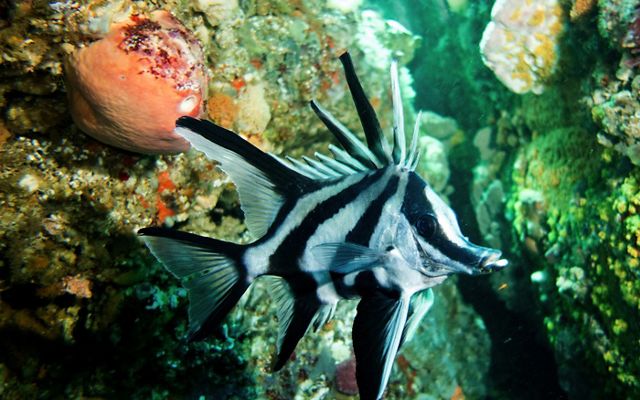
Longsnout Boarfish
Scientific name: Pentaceropsis recurvirostris
Other names: Boarfish, Duckfish, Long Nose, Longnose Boarfish, Boarfish
Max size: 50cm
Diet: Carnivore – Feeds on polychaete worms, brittle stars, and brown algae.
Habitat: Rocky reefs and sandy areas in coastal waters and bays, in depths of 3-260m.
General description: Large distinctive fish with deep, compressed bodies, large ‘spiky’ looking fins and an almost tubular snout with a small mouth. Longsnout Boarfish are whitish with two dark angled bands on sides, and a dark band from the front of the dorsal fin to snout tip. Fins also with dark markings. Juveniles have large brownish blotches covering the body, dorsal and anal fins.
Warning: Longsnout Boarfish have venomous spines.
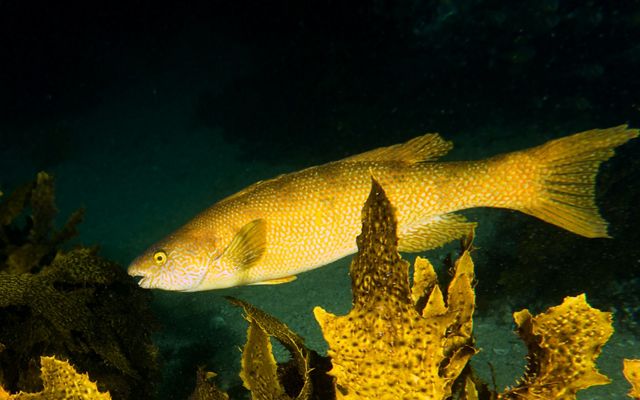
Herring Cale
Scientific name: Olisthops cyanomelas
Other names: None
Max size: 30cm
Diet: Herbivore – Feeds on the kelp
Habitat: On exposed reefs along the coast, often close to shore amongst kelp and large macroalgae in depths of 1-30 m.
General description: Like most wrasses, this species changes both sex and colour throughout its life. Juveniles are greyish to brownish above, yellowish below, with dark brown blotches, spots and lines, and a broken pearly stripe on the side. Females are brown, darker above, with narrow blue wavy lines on the head; each scale with bluish white spot, fins brown with wavy blue lines. Males are pale blue to almost black with bright blue lines along the margins of the caudal fin, along the leading edge of the pectoral fin and on the snout.
They have teeth in both jaws fused into a parrot-like beak with serrate edges.
Eastern Shovelnose Stingaree
Scientific name: Trygonoptera imitata
Other names: None
Max size: 80cm
Diet: Carnivore – Feeds mostly on bottom-dwelling invertebrates.
Habitat: Inhabits sandy and muddy bottoms in shallow bays, estuaries and inshore coastal waters at depths of about 5-120 metres. May occur in deeper waters in South Australia.
General description: Large plain-coloured with a relatively deep-body, a smooth rhomboidal to subcircular disc, two venomous spines, a long fin on the tail and no dorsal fin. The upper surface is brown to dark brown, sometimes with scattered darker and lighter spots, and the underside is pale usually with a broad darker margin.
Warning: a sting from the venomous spines may be excruciatingly painful.
Conservation: Recorded on the IUCN Red List as near threatened. The Eastern Shovelnose Stingaree has been intensively fished. They are usually caught in shallow water in small catches it is relatively robust after discard. They also tend to get caught and later discarded in some locations where heavy trawl gear is used and catches are more substantial.
Partial protection is offered in the inshore extremities of embayments and in marine reserves such as Port Phillip Heads Marine National Park where commercial fishing activities are not permitted. However, a steady decline has been reported in Port Phillip Bay over a 10 year period. A lack of trawling in Bass Strait provides reasonable protection for the species across a large portion of its range.
Watch Reef Cam
Now that you've familiarised yourself with some of the locals. Watch Reef Cam to test your knowledge!

